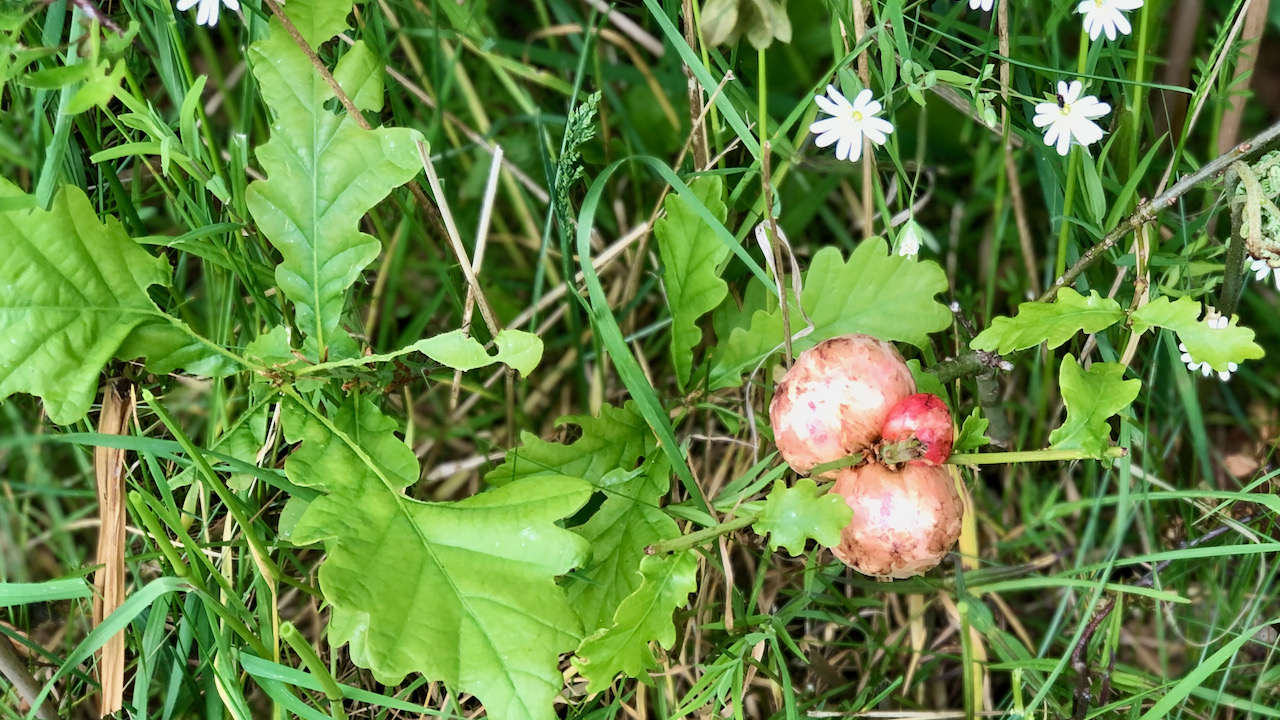While cutting back the bracken in Newton Wood today, I was taken by surprise when I stumbled upon what seemed to be miniature apples. Of course, these were not genuine apples, but rather galls created by insects as excrescences.
And as it dawned on me that they were attached to a small oak sapling instead of the hawthorn that towered over it, I realised that they were the galls of an Oak Gall Wasp.
The adult female wasp lays her eggs in the developing leaf buds, and once hatched, the larvae secrete chemicals into the oak tree. These chemicals prompt the growth of gall tissue, which serves as both food and protection for the developing larvae until they undergo metamorphosis and become adult wasps.
More interesting are the customs associated with oak apples, although perhaps a few days early for this blog. The 29th of May is a day that commemorates the Restoration of Charles II and is known by various names: Oak-apple Day, Oak-ball Day, Royal Oak Day, and Shick-shack Day. This odd alliteration of Shick-shack itself has many regional permutations: sheets-axe, shick-sack, shiff-shack, shiff-shig, shiff-shag, shit-sack, shit-zack, shuck-shack1“The English Dialect Dictionary, Being the Complete Vocabulary of All Dialect Words Still in Use, or Known to Have Been in Use during the Last Two Hundred Years; Founded on the Publications of the English Dialect Society and on a Large Amount of Material Never before Printed”. In six volumes edited by Joseph Wright, 1898. Volume V. Page 380. Internet Archive, 2014, https://archive.org/details/englishdialectdi05wriguoft. Accessed 10 Apr. 2021..
The shick-shack, a branch of oak and best adorned with an oak-apple, is primarily worn by schoolchildren before noon. However, in the afternoon, it is cast aside and replaced with monkey-powder, which consists of ash leaves. By evening, both emblems must vanish, otherwise, the individuals wearing them face the consequence of being beaten with stinging nettles. In other regions, the punishment for not wearing any oak leaves whatsoever is also a thrashing with nettles. Here in Yorkshire, a boy who neglects to wear the oak is mockingly referred to as a Papish2Wright, E.M., “Rustic Speech and Folk-lore”. lccn=14004537, H. Milford, 1913, https://books.google.co.uk/books?id=deWBAAAAMAAJ..
The festivities extend beyond children, as even men enthusiastically participate. They would wake up early to collect oak branches adorned with galls, which they would place on their hats or anywhere on their attire. Additionally, they would hang these branches on knockers, latches, and other parts of wealthy households’ doors. Once breakfast is over, these men would visit such houses in search of beer and ale. If they were not offered anything, they would recite the following verse:
Shig-shag, penny a rag,
Bang his head in Croommell’s bag,
All up in a bundle.
After noon, loyalty ceases. And if anyone is then accused of shig-shag, the following verses are recited:
Shig-shags gone past.
You’re the biggest fool at last.
When shig-shag comes again.
You’ll be the biggest fool then,
- 1“The English Dialect Dictionary, Being the Complete Vocabulary of All Dialect Words Still in Use, or Known to Have Been in Use during the Last Two Hundred Years; Founded on the Publications of the English Dialect Society and on a Large Amount of Material Never before Printed”. In six volumes edited by Joseph Wright, 1898. Volume V. Page 380. Internet Archive, 2014, https://archive.org/details/englishdialectdi05wriguoft. Accessed 10 Apr. 2021.
- 2Wright, E.M., “Rustic Speech and Folk-lore”. lccn=14004537, H. Milford, 1913, https://books.google.co.uk/books?id=deWBAAAAMAAJ.

Leave a Reply